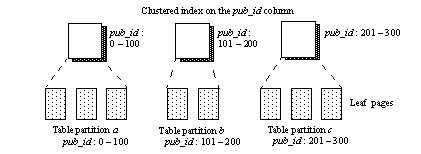All local indexes are equipartitioned with the base table’s data partitions; that is, they inherit the partitioning type and partition key of the base table. Each local index spans just one data partition.
You can create local indexes on range-, hash-, list-, and round-robin–partitioned tables. Local indexes allow multiple threads to scan each data partition in parallel, which can greatly improve performance.
Local Clustered Indexes
When a table is partitioned, rows are assigned to a partition based on value, but the data is not sorted. When a local index is created, each partition is sorted separately.
This figure shows an example of partitioned clustered indexes on a partitioned table. The index is created on the pub_id column, and the table is indexed on pub_id. This example can enforce uniqueness on the pub_id column.
create clustered index publish6_idx on publishers(pub_id) local index p1, p2, p3

create clustered index publish7_idx on publishers(pub_name) local index p1, p2, p3

The information in each data partition conforms to the boundaries established when the partitions were created, which means you can enforce unique index keys across the entire table.
Local Nonclustered Indexes
You can define local nonclustered indexes on any set of indexable columns.
create nonclustered index publish8_idx (A) on publishers(pub_id, city) local index p1, p2, p3
create nonclustered index publish9_idx (B) on publishers(city) local index p1, p2, p3
This example shows both examples of nonclustered local indexes. The graphic description of each is identical. However, you can enforce uniqueness on example A; you cannot enforce uniqueness on example B.
